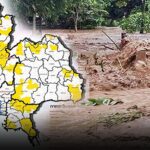CHIANG RAI – Northern Thailand is entering an era where green development is no longer just an idea. A small decrease in Thailand’s forest area, only 0.03%, is now having an effect on supply chains across the north and is a sign for the whole country to take notice.
On a misty morning in Doi Tung, visitors still take in the sights, but now there is a new topic of conversation: the latest figures on Thailand’s forest area for 2024. The country now holds forest cover at 31.46% of its land, about 101.78 million rai, down by roughly 32,884 rai or 0.03% from the year before.
While this sounds minor, for places like Chiang Rai, where the economy depends on natural resources, even small losses matter.
Local incomes from tourism, highland agriculture, food production, and water quality from upstream forests are all linked to healthy forests. This minor decline is now putting the entire northern economy to the test.
Forest Data Over a Decade: Loss Outpaces Gains
Over the last ten years (2015–2024), Thailand gained around 332,000 rai in new forests but lost over 832,000 rai in the same period. These numbers highlight a chronic issue: forest recovery efforts cannot keep up with land conversion and recurring risks.
Key Reasons for Gains
- Natural regeneration in some areas
- Tree planting for economic or conservation benefits
Key Reasons for Decline
- Land is being used for other activities
- Ongoing wildfires, which remain a recurring danger
- Development projects that use forest land still impact natural resources
Economic Impact and the Place of Forests in Chiang Rai’s Economy
1. Forests as Foundations for Income in Chiang Rai
Chiang Rai’s economy is built on tourism and high-value agriculture. Water sources originate from forests and sustain tea, coffee, cool-climate fruit, and organic farming, especially in the valleys. Eco-tourism, local homestays, community crafts, and farm-to-table businesses all start with forest health.
When even a small area of forest disappears, the hidden costs pile up: there is a higher risk of floods and droughts, poorer air during the dry season, and rising costs for health and tourism businesses. All these eat into profits, even if people do not notice it day to day.
2. The Ongoing Threat of Wildfire
While national figures only show a small decrease, the north – especially hill areas – faces the annual risk of wildfires and smoke. Tourism businesses, especially during the dry and hot season, suffer when air quality worsens. Everything from trip cancellations to higher insurance costs for visitors now depends on the number of clear-air days, which are linked directly to controlling fires and managing forest fuel loads.
3. Economic Opportunities in the Forest
Forests that remain or grow now drive new opportunities. Sustainable tourism, high-value agriculture like tea and coffee, and payment schemes for ecosystem services attract both visitors and investors. The local carbon credit market is also getting interest. For Chiang Rai, where branding focuses on clean air, natural beauty, and strong culture, keeping forests healthy is not just about the environment but a focused strategy for boosting income.
4. Raising Provinces’ Competitiveness
Several provinces in the north and central regions have increased their forest area by planning carefully and encouraging communities to get involved in forest management. This approach helps them create green products, GI goods, and develop low-carbon tourism.
Chiang Rai, at the crossroads of major tourism routes (such as Doi Tung, Mae Sai, Mae Fah Luang, and Mae Chan), needs to turn its natural strengths into real economic advantages by preserving its forests.
Chiang Rai’s Pivotal Role in the North
Chiang Rai is not among the provinces with increased forest in the latest year, but it sits at the centre of a region that loses forest area the fastest. The north has around 63.19% forest cover (about 37.95 million rai), but lost close to 29,884 rai in 2024 alone. These figures are a warning for Chiang Rai, highlighting that the area is at risk of falling behind.
Why Chiang Rai Must Make Forests a Top Priority
- Water sources such as the Kok, Ing, and upper Mekong rivers rely on forested areas in districts like Mae Fah Luang, Mae Sai, and along the border. Less buffer forest means less stable water for farming, tourism, and food industries.
- Air quality is central to visitors’ confidence in Chiang Rai. Cities that can control wildfires and smoke will attract families, athletes, and trekkers who are willing to spend more.
- Green finance is becoming available for local tree planting, forest fire management, carbon credit projects, and low-carbon tourism. Chiang Rai’s strong communities are in a good position to act as pilot schemes for green investment.
Practical Steps for Chiang Rai
- Develop clear land use plans at sub-district and small watershed levels, setting up community-forest buffer zones and assigning fuel management quotas for each season.
- Support high-value agroforestry (like tea, coffee, macadamia, and cool-climate fruit) alongside environmental standards to secure premium prices.
- Build low-carbon travel routes, such as city walks, bike paths, and light trekking that connect museums, art hubs, and ethnic communities, aiming to boost per-visitor spending with experience-based packages.
- Improve real-time wildfire and fuel load data systems for tourism and agricultural operators to adjust activities and reduce cancellations.
The Bigger Picture for Northern Thailand in 2024
The northern region holds the highest proportion of forests in Thailand, but also suffers the greatest overall annual losses. Other regions show different trends:
- The West has 58.82% of its land as forest, with a loss of over 12,400 rai
- The south stands at 24.33% forest with a decrease of 5,225 rai
- The northeast has 14.89% forest, down by 732 rai
- The east managed to gain 4,374 rai, now covering 21.84% the land
- The central region gained the most, with 11,032 rai added to reach 21.57% forest cover
Central and eastern provinces have made gains by focusing on careful planning and economic benefits for communities. The north can adapt these strategies, but will also need fresh ideas for managing fuel loads, handling wildfires, and creating new incomes during the dry season to stop the cycle of forest loss.
Across the Country: Lessons in Forest Recovery
Many provinces, including Phayao, Nan, Phrae, Phitsanulok, Phetchabun, Uthai Thani, Chainat, Lopburi, Saraburi, Suphan Buri, Ang Thong, Nakhon Pathom, Prachinburi, Chachoengsao, Sa Kaeo, Chon Buri, Rayong, Chumphon, Satun, Nong Khai, Bueng Kan, Chaiyaphum, Khon Kaen, Kalasin, Roi Et, Nakhon Ratchasima, Buri Ram, and Surin, show that expanding forest area is possible with the right focus and tools.
Yet, there are still two provinces with no forest at all: Nonthaburi and Pathum Thani. These are urban centres facing the challenge of balancing city growth with green space. Meeting this challenge will help them reduce heat and improve air quality, supporting investment and quality of life.
A drop of just 0.03% in a single year may not seem serious, but the overall decade-long trend shows a consistent loss. Thailand needs to shift its approach. Chiang Rai now faces a key question: how to turn its natural setting into a source of ongoing, competitive advantage.
Immediate Action: Four Strategic Moves
- Plan the economy based on water catchment areas, aligning farming, tourism, and services with the capacity of upstream forests rather than just administrative boundaries.s
- Create deals for ecosystem services between urban centres and upland communities, letting city operators pay for forest care in exchange for clean water, air, and a stronger green image.
- Raise standards for low-carbon tourism across hotels, tours, and cafes, linking products to both environmental targets and local cultural identity.
- Develop agroforestry into a regional industry, connecting tea, coffee, and fruit supply chains to processors and cooler logistics, boosting value and lowering pressure on forests.
- Use open data and dedicated dashboards to give local businesses early warnings about fire risk, helping them plan events and keep guests informed.d
Forests as Economic Assets: The Chiang Rai Model
When forests are seen as assets, the economic cycle in Chiang Rai and the north becomes much stronger. Healthy forests lead to cleaner water and air, support valuable farming and tourism, and feed money back to local communities. This, in turn, brings back more forest cover.
Key Forest Facts for Thailand in 2024
- National forest area: 31.46%, or about 101,785,272 rai
- Change since last year: a decrease of 0.03% (32,884 rai)
- Over the past 10 years,s: 332,000 rai gained and 832,000 rai lost
- Northern region: 63.19% forest, losing 29,884 rai (largest decrease)
- Central region: 21.57% forest, gaining 11,032 rai (largest increase)
- Forestless provinces: Nonthaburi, Pathum Thani
Losing just 0.03 of % forest might seem unimportant in daily headlines. For Chiang Rai, which relies on green growth, it raises real concerns about future income and liveability. Now, the region must treat its forests as economic assets needing professional management.
If this happens, Chiang Rai will not only be better prepared for the annual haze but could stand out as a green city for the north, where nature is a direct source of jobs, money, and pride for its people.














